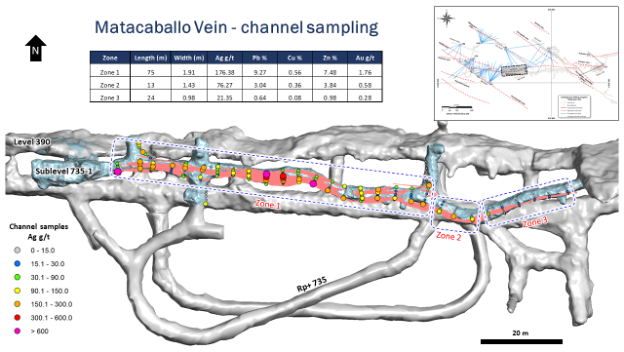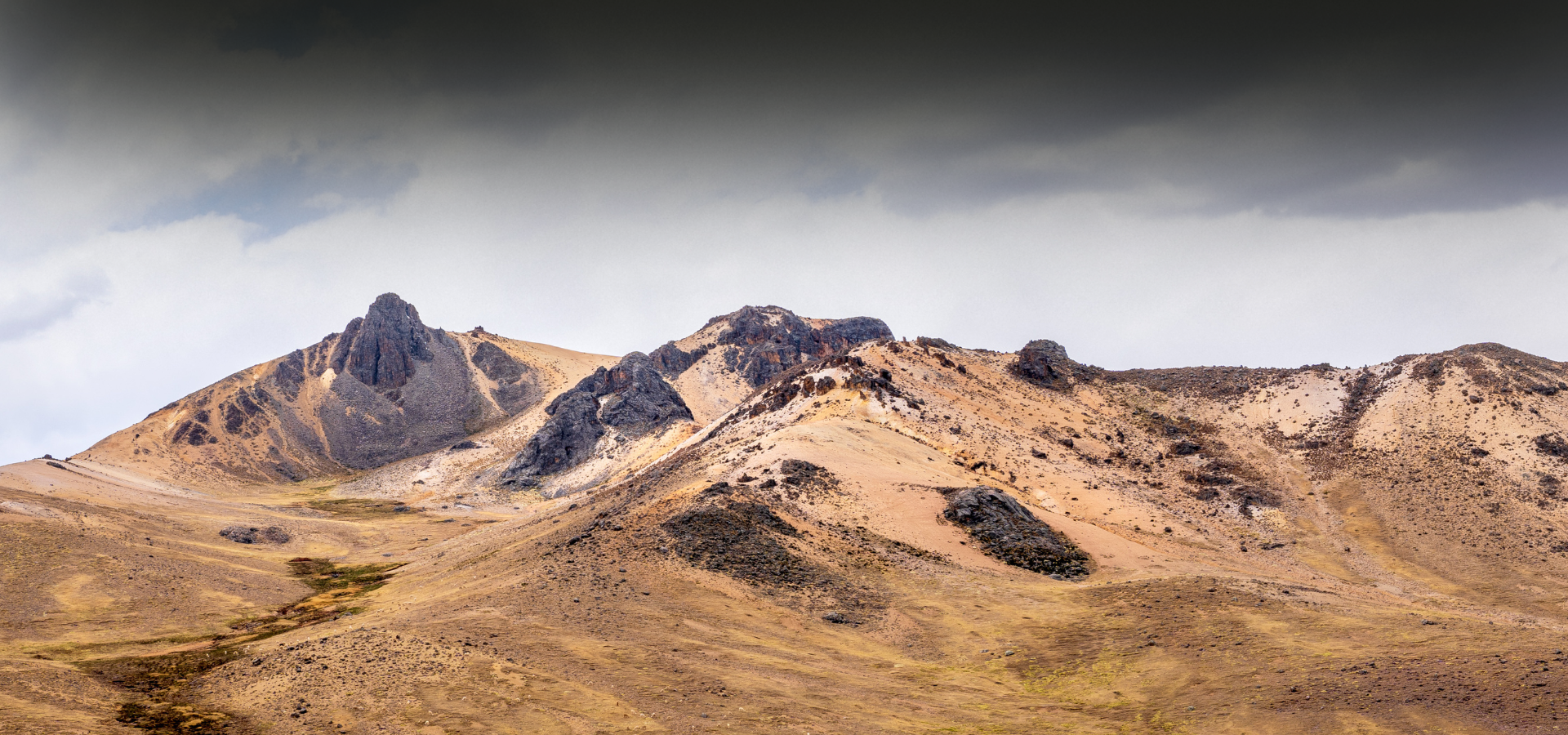SILVER MOUNTAIN REPORTS NEW UNDERGROUND CHANNEL SAMPLING RESULTS FROM ITS RELIQUIAS MINE
NOT FOR DISTRIBUTION TO U.S. NEWSWIRE SERVICES OR DISSEMINATION IN OR INTO THE UNITED STATES
Highlights:
- 2.87m @ 476 g/t Ag, 15.34 g/t Au, 5.71% Pb, 6.21% Zn, and 0.24% Cu
- 1.94m @ 544 g/t Ag, 1.62 g/t Au, 12.83% Pb, 18.26% Zn, and 1.62% Cu
- 1.16m @ 157 g/t Ag, 8.16 g/t Au, 7.67% Pb, 12.79% Zn, and 1.20% Cu
Toronto, Ontario, December 7, 2022 – Silver Mountain Resources Inc. TSXV:AGMR | OTCQB:AGMRF | BVL:AGMR (“Silver Mountain“, “AGMR” or the “Company“) is pleased to announce new results from underground channel sampling at the Reliquias silver mine in Huancavelica, central Peru. To complement the drill campaign and to facilitate the conversion of additional historic resources into a National Instrument 43-101 – Standards of Disclosure for Mineral Projects (“NI 43-101”) compliant mineral resource, an extensive underground mapping and sampling program is in progress at Reliquias. Several existing drifts, sublevels, and raises were mapped and systematically sampled in channels cut across the exposed veins.

Assays have been received for 263 rock channel samples taken from three zones along Sublevel 735-1, part of the 390 m level of the Matacaballo structure (Fig.1 to 3). This zone of well-developed mineralization in the Matacaballo Vein is exposed over 112 m along sublevel 735-1. The unmined stopes of this drift are located above the main 390 m level and have already been developed for mining (Fig.1). The extensions of the Matacaballo vein to the west and east at the same depth were exploited in the past, which indicates that well-developed mineralization was present along strike as well.

Samples were taken using an electric percussion hammer to produce a channel perpendicular across the veins and mineralized structures. By cutting a continuous channel approximately 3-5 cm deep by 10 cm wide, the channel samples are essentially equal to a drill core in their significance for future resource estimation. Where the structure is exposed along the back of the drift, channels were cut across the vein systematically every 4 m. Channel lengths range between 0.87 m and 2.88 m.
The underground sampling results from this part of the Matacaballo Vein confirm the continuity of well-developed polymetallic mineralization within the structure, with significant concentrations of silver (Ag), lead (Pb), zinc (Zn), and copper (Cu). To highlight the continuity of this vein system, the grades and widths of channels were averaged over each of the three zones shown in Fig. 2 and 3. Weighted gold grades over sample channels – on average 2.49 g/t Au in zone 1– were higher than expected, ranging between 0.07 g/t and 15.34 g/t (data uncapped). A total of 26 individual rock channel samples returned over 1 g/t Au, with a maximum value of 98.5 g/t Au. When applying a cap of 30 g/t Au to the sample results to avoid overestimation of the gold content, the average gold grade for zone 1 still reaches 1.76 g/t Au (Tab.1).
Alfredo Bazo, President and CEO, commented: “The underground sample results from sublevel 735-1 provide verification of the continuity of high-grade Ag-Pb-Zn-Cu mineralization in the Matacaballo Vein. We are strongly encouraged by the encountered gold grades, which most likely will positively impact the results of our future resource estimate. Since this sublevel of the Matacaballo structure is already developed for extraction, it will certainly be considered for the mine start-up in late 2023.”

The Matacaballo structure exhibits brecciation, irregular banding and crustiform textures typical of intermediate sulphidation veins. Sulphide minerals are present as semi-massive pods, fine veinlets, or in disseminated form, within a matrix composed of several generations of quartz, with minor rhodochrosite. Galena, sphalerite, silver sulpho-salts, chalcopyrite, and minor pyrite were encountered. In the hanging as well as the foot wall, the central Matacaballo vein is accompanied by 20 to 50 cm wide splays, which show brecciation and contain sulphides as matrix or in cockade textures around argillized wall rock clasts.


The following table provides more detail regarding the channel sample results from sublevel 735-1 of the Matacaballo Vein structure.

On Behalf of the Board of Directors of Silver Mountain Resources Inc.
Alfredo Bazo, Chief Executive Officer and Director
Qualified Person
The scientific and technical information contained in this news release has been reviewed and approved by Antonio Cruz, an independent consultant of the Company and a Qualified Person within the meaning of NI 43-101.
About Silver Mountain
Silver Mountain Resources Inc. is a silver explorer and mine developer planning to restart production at the Reliquias underground mine and undertake exploration activities at its prospective silver camps at the Castrovirreyna Project in Huancavelica, Peru.
For additional information in respect of the Castrovirreyna Project, please refer to the Company’s technical report, titled National Instrument 43-101 Technical Report—Castrovirreyna Project, Peru, dated October 6, 2021, amended November 18, 2021, effective date August 17, 2021, available at https://sedar.com.
Silver Mountain’s subsidiary Sociedad Minera Reliquias S.A.C. owns 100% of its concessions and holds more than 27,000 hectares in the district of Castrovirreyna, Huancavelica, Peru.
For Further Information Contact:
Alfredo Bazo Jean Pierre Fort
President, CEO & Director Chief Financial Officer
Silver Mountain Resources Inc
82 Richmond Street East
Toronto, ON M5C 1P1
Sampling, QA/QC and Analytical Procedures
Silver Mountain follows systematic and rigorous sampling and analytical protocols which meet industry standards. These protocols are summarized below.
All channel samples were collected with an electric percussion hammer and do not exceed 1.0 m in length. Channels are broken at obvious geologic boundaries to correctly separate rock types and mineralization styles. The sample bags were sealed with a plastic zip tie and identified with a unique sample number, pending shipment to a certified laboratory sample preparation facility. Samples are sent by batch to the ALS laboratory in Lima for assaying. Silver Mountain independently inserts certified control standards (purchased from OREAS and Target Rocks), fine and coarse blanks, and duplicates into the sample stream to monitor data quality. These standards are inserted “blindly” to the laboratory in the sample sequence prior to departure from the storage facilities. At the laboratory samples are dried, crushed, and pulverized and then analyzed using a fire assay-AA finish analysis for gold and a full multi-acid digestion with ICP-AES analysis for other elements. Samples with results that exceed maximum detection values for the main elements of interest (Ag, Zn, Pb, Cu, Au) are re-analyzed using precise ore-grade ICP analytical techniques, while high gold values are re-analyzed by fire assay with a gravimetric finish.
Forward Looking Statements
This news release contains forward-looking statements and forward-looking information within the meaning of Canadian securities legislation (collectively, “forward-looking statements“) that relate to Silver Mountain’s current expectations and views of future events. Any statements that express, or involve discussions as to, expectations, beliefs, plans, objectives, assumptions or future events or performance (often, but not always, through the use of words or phrases such as “will likely result”, “are expected to”, “expects”, “will continue”, “is anticipated”, “anticipates”, “believes”, “estimated”, “intends”, “plans”, “forecast”, “projection”, “strategy”, “objective” and “outlook”) are not historical facts and may be forward-looking statements and may involve estimates, assumptions and uncertainties which could cause actual results or outcomes to differ materially from those expressed in such forward-looking statements. No assurance can be given that these expectations will prove to be correct and such forward-looking statements included in this news release should not be unduly relied upon. These statements speak only as of the date of this news release.
Forward-looking statements are based on a number of assumptions and are subject to a number of risks and uncertainties, many of which are beyond Silver Mountain’s control, which could cause actual results and events to differ materially from those that are disclosed in or implied by such forward-looking statements. Such risks and uncertainties include, but are not limited to, the factors set forth under “Forward-Looking Statements” and “Risk Factors” in the Company’s final prospectus dated January 26, 2022, and other disclosure documents available on the Company’s profile at www.sedar.com. Silver Mountain undertakes no obligation to update or revise any forward-looking statements, whether as a result of new information, future events or otherwise, except as may be required by law. New factors emerge from time to time, and it is not possible for Silver Mountain to predict all of them or assess the impact of each such factor or the extent to which any factor, or combination of factors, may cause results to differ materially from those contained in any forward-looking statement. Any forward-looking statements contained in this news release are expressly qualified in their entirety by this cautionary statement.
